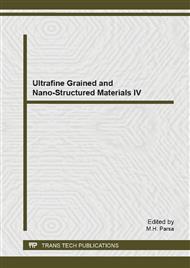[1]
H. C. Man, S. Zhang, F. T. Cheng, and T. M. Yue, MIcrostrucure and formation mechanism of in situ synthesized TiC/Ti surface MMC on Ti-6Al-4V by laser cladding, vol. 44, p.2801–2807, (2001).
DOI: 10.1016/s1359-6462(01)00977-0
Google Scholar
[2]
Y. Fu and A. W. Batchelor, Laser nitriding of pure titanium with Ni, Cr for improved wear performance, Wear, vol. 214, no. 1, p.83–90, Jan. (1998).
DOI: 10.1016/s0043-1648(97)00204-4
Google Scholar
[3]
A. F. Saleh, J. H. Abboud, and K. Y. Benyounis, Surface carburizing of Ti – 6Al – 4V alloy by laser melting, Optics and Lasers in Engineering, vol. 48, no. 3, p.257–267, (2010).
DOI: 10.1016/j.optlaseng.2009.11.001
Google Scholar
[4]
P. Chandrasekar, V. Balusamy, K. S. R. Chandran, and H. Kumar, Laser surface hardening of titanium–titanium boride (Ti–TiB) metal matrix composite, Scripta Materialia, vol. 56, no. 7, p.641–644, Apr. (2007).
DOI: 10.1016/j.scriptamat.2006.11.035
Google Scholar
[5]
S. Zhang, W. T. Wu, M. C. Wang, and H. C. Man, In-situ synthesis and wear performance of TiC particle reinforced composite coating on alloy Ti6Al4V, Surface and Coatings Technology, vol. 138, no. 1, p.95–100, Apr. (2001).
DOI: 10.1016/s0257-8972(00)01133-6
Google Scholar
[6]
M. D. Abad and A. Fernández, Surface & Coatings Technology Metal carbide / amorphous C-based nanocomposite coatings for tribological applications, Surface & Coatings Technology, vol. 204, no. 6–7, p.947–954, (2009).
DOI: 10.1016/j.surfcoat.2009.05.038
Google Scholar
[7]
Yang, Y., Zhang, D., Yan, W., & Zheng, 'Microstructure and wear properties of TiCN/Ti coatings on titanium alloy by laser cladding',. Optics and Lasers in Engineering, 48(1), (2010).
DOI: 10.1016/j.optlaseng.2009.08.003
Google Scholar
[8]
A. Lisiecki and A. Klimpel, Diode laser surface modification of Ti6Al4V alloy to improve erosion wear resistance, Archives of Materials Science and Engineering, vol. 32, no. 1, p.5–12, (2008).
Google Scholar
[9]
W. U. Wanliang, Microstructure of TiC dendrites reinforced titanium matrix composite layer by laser cladding, no. mm, p.1169–1171, (2003).
Google Scholar
[10]
R. M. Mahamood, E. T. Akinlabi, M. Shukla, and S. Pityana, Scanning velocity influence on microstructure , microhardness and wear resistance performance of laser deposited Ti6Al4V / TiC composite, Materials and Design, vol. 50, p.656–666, (2013).
DOI: 10.1016/j.matdes.2013.03.049
Google Scholar
[11]
J. J. Candel, V. Amigó, J. A. Ramos, and D. Busquets, Surface & Coatings Technology Sliding wear resistance of TiC p reinforced titanium composite coating produced by laser cladding, vol. 204, p.3161–3166, (2010).
DOI: 10.1016/j.surfcoat.2010.02.070
Google Scholar
[12]
R. Filip, Alloying of surface layer of the Ti-6Al-4V titanium alloy through the laser treatment, vol. 15, no. 1, p.174–180, (2006).
Google Scholar
[13]
Q. W. Meng, L. Geng, B.Y. Zhang, 'Laser cladding of Ni-base composite coatings onto Ti-6Al–4V substrates with pre-placed B4C+NiCrBSi powders', Surface and Coatings Technology, 200(16-17), (2006).
DOI: 10.1016/j.surfcoat.2005.04.059
Google Scholar


